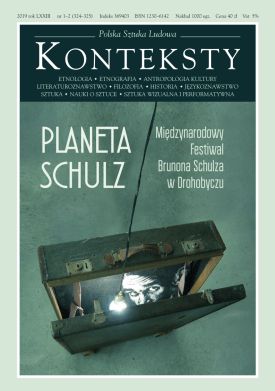Chwasty Schulza
Schulz’s Weeds
Author(s): Stanley BillSubject(s): Language and Literature Studies, Fine Arts / Performing Arts
Published by: Instytut Sztuki Polskiej Akademii Nauk
Keywords: Bruno Schulz;flora
Summary/Abstract: The world created by Bruno Schulz is full of plants: in his stories we frequently come across descriptions of assorted vegetation and extensive metaphorics based on botanical comparisons. Already the great ingenuity of Schulzian language suggests the lushness of plants. At the same time, Schulz described the origin and structure of history and myths with the intermediary of the same metaphorics. According to this conception his stories constitute precisely regrowth, regeneration, “new greenery” or “green coating” rejuvenating the branches of old myths. Schulz’s imagination is profoundly botanical. The author of this essay concentrates on a specific variety of omnipresent plants, i.e. weeds. Weeds – or wild growing plants in a wider sense – play a specially important part in the world of Schulz’s stories by representing the unusual “fertility” of vegetation and mindless life in its purest form. Within the range of the town, where the plot of the stories as a rule takes place, this impersonal form of life comprises the decisive majority of the described plants, both literally and metaphorically. Moreover, in the world depicted by Schulz weeds possess a specifically significant ontological status because they grow along an uncertain borderline between culture and Nature.On the one hand, weeds do not belong to the world of human forms albeit, on the other hand, they are not part of wild Nature. In Schulz’s stories – just as in extra-literary reality – weeds blossom and develop best of all in courtyards and garden flowerbeds, on walls and roofs, and in streets and roadside ditches. They need people and their activity. Weeds are not only opponents of created forms of human culture but to a certain degree they are its products. In this sense they are archetypical beings of Schulz’s borderline between wild matter and human form.
Journal: Konteksty
- Issue Year: 324/2019
- Issue No: 1-2
- Page Range: 142-146
- Page Count: 5
- Language: Polish
- Content File-PDF

